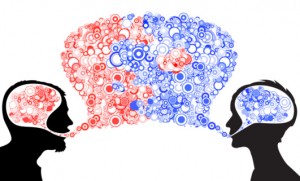
One of the ways that I love to work with my clients is via one-on-one coaching because it often allows for more accelerated progress. I have been fortunate to have worked closely with one of the most experienced and perceptive coaches I know – my dear friend and ex-colleague, Debbie Mattsson-Clarke. Debbie and I have been discussing some interesting areas in recent months and I wanted to share some of this with you.
I was particularly interested in getting Debbie’s thoughts on the topic of communication – something that is central to who we are as humans. “Com” means with/ “Union” means to bring together two parts. Therefore “to communicate” is to have a unity experience with another or others. This is the goal of all meaningful interactions.
JL: In your opinion what are the key elements for effective communication?
DMC: In every communication situation, whether it is one-to-one, one-to-many or group-to-group there is a Sender (or senders) and a Receiver (or receivers). Everyone has a natural preference in how they communicate: the words they use, the channel they choose (face-to-face, phone, mail, text,) the amount of detail they include and whether they plan and think about it in advance or just do it spontaneously. It is the natural tendency of all Senders to communicate in the way that suits them. Then they wonder why they have not got their message across, been misunderstood, caused offence or not got the action they expected.
Instead of the Sender putting themselves in the spotlight, they actually need to put the Receiver in the spotlight.
JL: What is your definition of effective communication?
DMC: The most effective communicators are those who spend time reflecting on what they know about the Receiver and how they are most likely to reach them. What are their preferred communication channels, what is their culture and background, what is their history in terms of their relationship with the Sender (or the group the Sender represents), what words or expressions trigger them negatively, what language do they use (not just geographical but in terms of phrases and terminology), what makes them feel positive, safe, understood, valued. If all these things are considered then you are off to a good start.
JL: In your experience with coaching people what are the most common issues that get in the way of effective communication?
DMC: The most common trap is when people get stuck in their own patterns of communication and stuck in how someone else ‘ought’ to be responding. It is like two people who speak totally different languages but think if they shout louder the other person will understand – they will not – the opposite in fact – they will shut down and give up.
When coaching I try to get people to do the following things:
• Always start by making an ‘analysis’ of your Receiver – everything you know about them so that you can see how your communication may be perceived through their eyes.
• Think about the purpose of your communication – what do you hope to achieve? If it is just to ‘let off steam’ then you need to do that elsewhere because all you will do is build up a negative history between you and the Receiver for the next time you try to communicate.
• Choose your communication channel, the time and place carefully. How often does someone actually ask you if now is a good time to talk? Being sure the person is in receiving mode is a big part of communicating effectively.
• Always acknowledge the other person’s situation, point of view and perspective. That doesn’t mean you have to agree with it but by showing you at least understand it, by reflecting back your understanding of it to them, you will have a better chance of avoiding them going in to defence and repeating their argument.
Most coaching is done with adults in a business situation but one can see the communication process in action at its most basic levels in families. Imagine a family of four, two adults and two children, in a car driving somewhere.
One child says “I’m thirsty”. One adult says “You can’t be thirsty, you had a drink before we left the house”. The child continues “I’m thirsty” because their need has not been acknowledged and they must continue to defend their statement.
The second child picks up the argument and adds “I’m thirsty” and the parent continues to say they should not be or that it is not possible to stop for a drink as they are on a motorway etc. etc.- all of which are valid, logical arguments but just increase the tension.
Let’s try another approach: the other adult says “I know you must be thirsty, it is a hot day, I think I will also be thirsty soon, let’s all keep our eyes open for a place to get a drink”. Immediately the child feels validated and seen – they do not need to keep on defending their statement. They are quiet and wait – tension disperses.
We never lose this need to be seen and validated, even as adults. The more we can do to confirm we have heard the Receivers view of things the more receptive they become to collaboration.

Debbie Mattsson-Clarke is the founder of The Global Development Network. Her background includes 12 years hands-on line management experience across 23 different countries as well as 8 years international consultancy experience. For more about Debbie and her work you can visit the following websites: